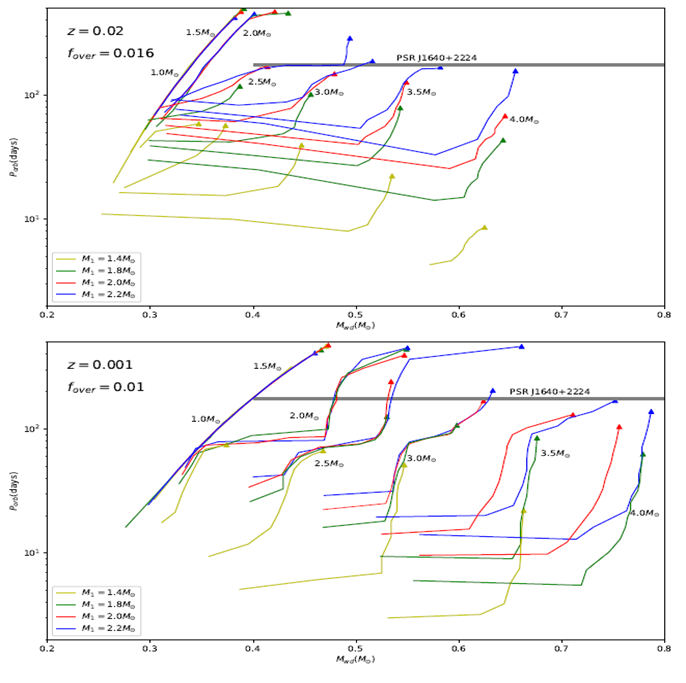PSR J1640+2224 is a binary millisecond pulsar with a spin period Ps=3.16 ms. It is located in a wide and nearly circular binary system that contains a white dwarf (WD) companion and an orbital period of 175 days. According to the theoretical relationship between mass and orbital period of a WD, the mass of the WD companion in this system should be 0.35-0.39  (
( is the solar mass),whose specific value depends on the initial metallicity of the companion. However, recent observational and theoretical studies found that the companion mass should be larger than 0.4
is the solar mass),whose specific value depends on the initial metallicity of the companion. However, recent observational and theoretical studies found that the companion mass should be larger than 0.4  in this system. In other words, PSR J1640+2224 belongs neither to a low-mass X-ray pulsar binary system nor a medium-mass X-ray pulsar binary system, so its formation process has become a puzzle in the field of X-ray binaries.
in this system. In other words, PSR J1640+2224 belongs neither to a low-mass X-ray pulsar binary system nor a medium-mass X-ray pulsar binary system, so its formation process has become a puzzle in the field of X-ray binaries.
In theory, the maximum mass of a neutron star (NS) can reach , but its initial mass at birth is not certain. The initial mass of a NS affects substantially on the evolution of a low-mass or medium-mass X-ray binary into a binary millisecond pulsar. In addition, metallicity is also an important parameter in stellar evolution as different metallicities will lead to different outcomes of stellar evolution.
, but its initial mass at birth is not certain. The initial mass of a NS affects substantially on the evolution of a low-mass or medium-mass X-ray binary into a binary millisecond pulsar. In addition, metallicity is also an important parameter in stellar evolution as different metallicities will lead to different outcomes of stellar evolution.
Under the guidance of supervision of Dr. GAO Zhifu, DENG Zhuling, a graduate student in the Pulsar Research Group at the Xinjiang Astronomical Observatory, Chinese Academy of Sciences, carried out a study of the formation of binary millisecond pulsar PSR J1640 + 2224. Results obtained from using the stellar evolution program and the method of numerical simulation, and combining with the equation of state of NS, show that the initial mass of this star is likely to be greater than 2  , and its metallicity could be less than that of the Sun (Z=0.02).
, and its metallicity could be less than that of the Sun (Z=0.02).
The results are published in The Astrophysical Journal (ApJ, 2020, 892, 4). They offer not only an explanation for the formation of the relatively special source PSR J1640+2224, which enrich the formation mechanism of millisecond pulsars, but also put more restrictions on some theoretical models of NSs.

Fig. 1. Final orbital period as a function of WD mass. The yellow, green, red and blue curves are for initial NS masses of  ,
, ,
, and
and , respectively. Beside each curve we label the initial donor mass. The gray, solid horizontal line represents the distribution of the orbital period and the WD mass for PSR J1640+2224. The triangles are used to distinguish different curves that overlap. In the top and bottom panels we adopt different chemical compositions and overshooting parameters (top: Population I and fover = 0.016; bottom: Population II and fover = 0.01).
, respectively. Beside each curve we label the initial donor mass. The gray, solid horizontal line represents the distribution of the orbital period and the WD mass for PSR J1640+2224. The triangles are used to distinguish different curves that overlap. In the top and bottom panels we adopt different chemical compositions and overshooting parameters (top: Population I and fover = 0.016; bottom: Population II and fover = 0.01).
The article links: https://ui.adsabs.harvard.edu/abs/2020ApJ...892....4D/abstract
Contact: GAO Zhifu
Xinjiang Astronomical Observatory, Chinese Acade
Email: zhifugao@xao.ac.cn